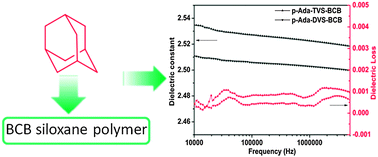Adamantyl-based benzocyclobutene low-k polymers with good physical properties and excellent planarity†
Abstract
Low dielectric polymers play an important role in replacing traditional inorganic dielectric materials in advanced electronic manufacturing due to their excellent physical and chemical properties. Herein we report the preparation and characterization of two novel low-k dielectric polymers by introducing adamantane into benzocyclobutene. Because the adamantyl group has low polarizability and can increase the free volume of the polymer, both polymers showed low dielectric constants (2.5) and low dielectric loss (<0.001) at the frequency within 10 KHz–5 MHz. They also showed excellent film uniformity and planarity with the surface roughness less than 0.6 nm and good hydrophobicity with the contact angle larger than 107°. Due to the high cross-linked network structure, both of the adamantyl-based BCB polymers exhibited high glass transition temperature (>350 °C), high storage modulus and good thermal stability (Td > 400 °C in nitrogen). Especially, the p-Ada-TVS-BCB polymer showed a low coefficient of thermal expansion (41 μm m−1 °C−1). All of these good properties are in accord with the requirement of the interconnect fabrication of Cu metallization using the damascene process. Both of the polymers are suitable for the utilization in the electronic packing industry.


 Please wait while we load your content...
Please wait while we load your content...